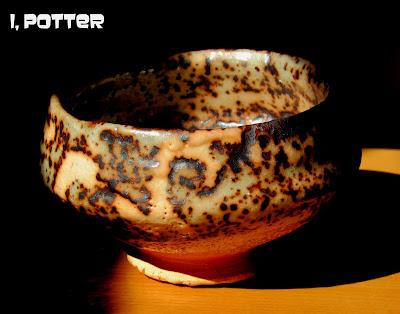Wednesday, April 17, 2024
ON THE OFF CHANCE
Monday, April 15, 2024
B&T
Friday, April 12, 2024
PRIMO REPARIO
At any rate, this Iga chawan was thrown out of a rather dense whitish stoneware in a rather classical Furutani Michio shape where the bowl form has a depressed area running close to the lip which has also allowed green ash to build up in and run down from. The entire chawan is covered in varying degrees of ash thickness with a wonderful run of a thick river up toward the lip culminating in a large bidoro drop and due to how the bowl was oriented during the firing there is a thick deep pool close to the lip on the interior which is quite prominent and very hard to miss. The foot has the least amount of ash buildup of the bowl and shows off the crisp cut foot with crinkled texture inside to its fullest advantage. I could go on and on about the chawan and what I discovered in deciding to take a risk on this chawan is that it has no impact on the pot from my viewpoint, someone, either potter, dealer or collector decided this chawan was just too special to discard and had it lovingly restored with the perfect choice of lacquer which has altered this piece into not only splendid work of a master at the height of his skills when made but a narration about survival and the need to understand that a kiln accident is not the end of the world but rather the beginning of a deeper conversation about the importance of objects to a tradition and humanity, the perfection of imperfection on full display.
Wednesday, April 10, 2024
HIGH TECH
Monday, April 8, 2024
RIN
Kurashima Taizan is well known for his wonderful, Song inspired ceramics and carving that runs from rather simple to very ornate and complex. As you can see in this simple, static photo, this vase embraces the concept of "RIN" or "quiet clarity" and his work was included in the exhibition, RIN (1996) showcasing his pale blue and ivory colored carved porcelains. As the accompanying catalogue details, Kurashima's works conjure up thoughts of purity and elegance and having handled a few of his pieces, it would be next to impossible to disagree with that conclusion.
Friday, April 5, 2024
MORE TO OFFER
Having shown his work across Japan and abroad, Hoshino has embraced the Shigaraki (haikaburi) aesthetic that relies on skill, experience and serendipity to complete his work in the anagama wood fired kiln. This pot, all naturally glazed, shizen-yu has a rough and tumble surface while still having a sense of nobility in the stance and posture of what is a utilitarian vessel with quite honestly, so much more to offer. Each encounter with the work of Hoshino expands the breathe of his output from simple to the complex masterful koro showing yet another potter not residing in the birthplace of the tradition making pots that display excellent examples of what is at the very heart of the Shigaraki tradition.
Wednesday, April 3, 2024
MOTIVATION
Monday, April 1, 2024
TRICKY BOWL
As for my personal take on this chawan, this has been one of my favorites that I have handled by Tsukigata Nahiko. I am unsure exactly how to explain it but it has a sense of antiquity and an eminently casual demeanor, more like it just happened than was thought out, thrown, manipulated and tooled. The bowl feels natural, well balanced on its pedestal foot and welcoming in the hands, I am not sure you get all of this from this photos and others, along with a video that I have made but since it is rather happy where it is, as is the owner, I don't think it will be making the rounds any time soon so this will just have to suffice until another one shows up, fingers crossed.
Friday, March 29, 2024
STRIKE A POSE
Illustrated is an ever so slightly different piece by Honiwa Rakunyu, a tall, slender and graceful Shigaraki hoso-chaire with a Kyoto style textile shifuku and a well crafted and excellently fitted lid. This slender form was likely fired inbetween two pots, slightly behind them as the face is covered in a fine, wet coating of ash that feathers off to the rear that is a darker brown hi-iro that is surrounded by a thin transitional border of an almost goma-like effect. At over 11.5cm tall this is a simple, resolute form intended for one dedicated purpose but the more I look at it the more I see that it serves as much for the eye as it does the hand and in this light strikes a distinct and timeless pose.
Wednesday, March 27, 2024
SOLVING PROBLEMS
Once the form was fixed, I beat the base so that the center of each plane formed the foot and the corners were a bit raised which makes for a nice shadow. Small paddled lugs were added at the shoulder and the lid has a step down which adds dimension to the surface along with the glaze run that also adds quite a bit of motion. The shoulder and upper plane had iron sprayed on them but the bottom of the form is just pure, straight Oribe and looks quite radiant and enticing in the sunlight. My goal this year is to make some larger versions of this idea along with varying the proprotion to see what I end up with and even after making some small bottles and a few covered jar I think I am safe in saying, I don't think I will get bored with solving problems or this idea and form anytime soon.


ip2.jpg)

ip.jpg)




